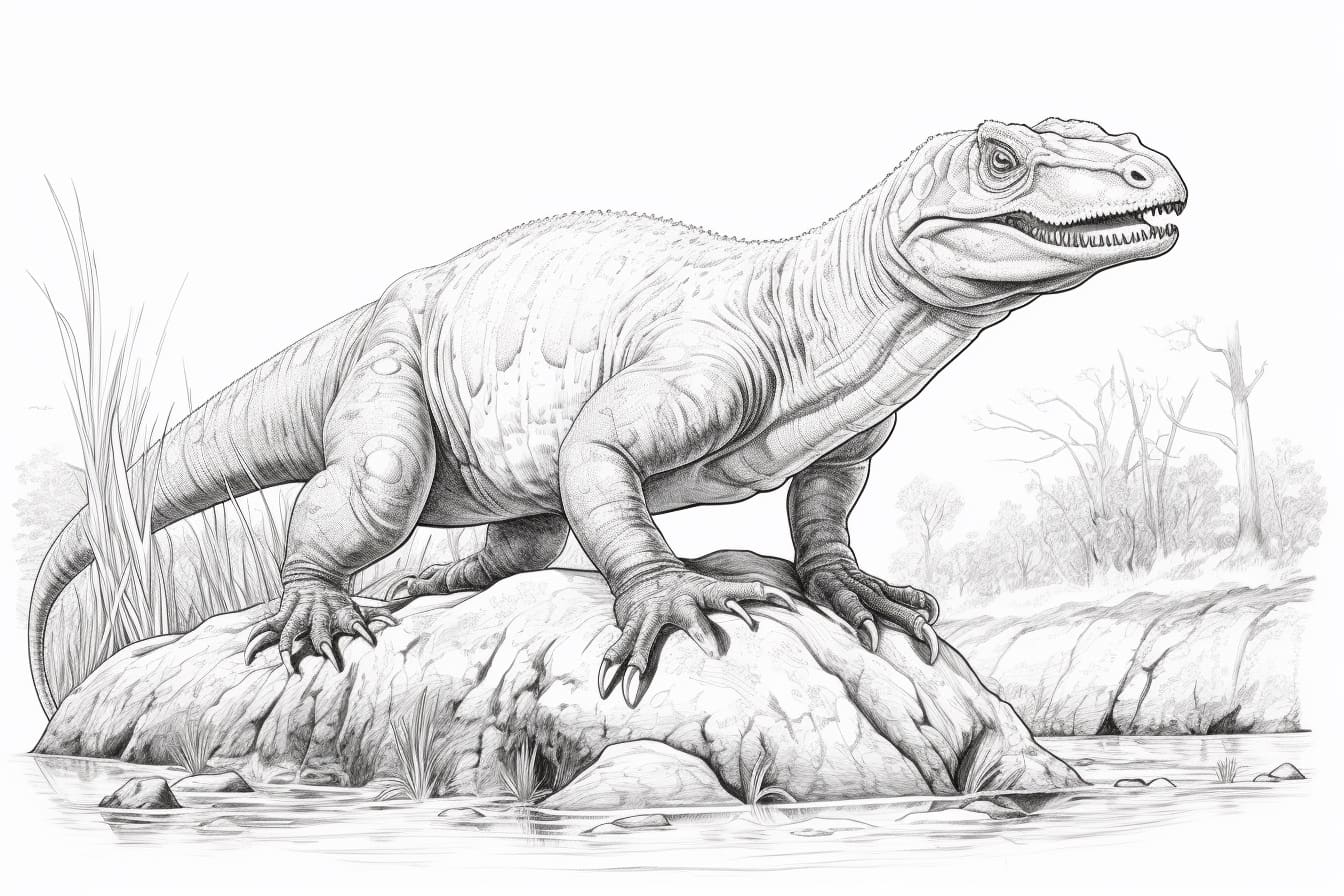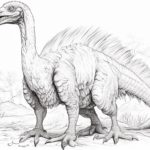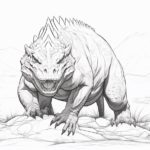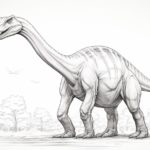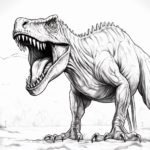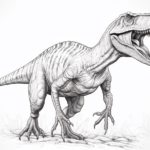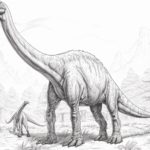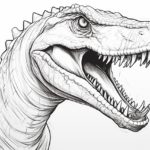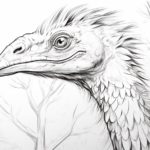Maiasaura, the “good mother lizard,” is a fascinating dinosaur that roamed the Earth during the Late Cretaceous period. Known for its nurturing behavior towards its young, this herbivorous dinosaur has captured the imagination of paleontologists and artists alike. Drawing Maiasaura allows us to explore its unique anatomy and bring this prehistoric creature to life on paper. In this guide, we will delve into the key features of Maiasaura and provide you with tips and techniques to create a realistic and captivating depiction of this remarkable dinosaur. So grab your pencils and let’s embark on a journey back in time to sketch the magnificent Maiasaura!
Materials Required
To draw a Maiasaura, you will need the following materials:
- Pencil: To sketch the outline and details of the Maiasaura.
- Eraser: To correct any mistakes or lighten lines.
- Paper: A sketch pad or drawing paper to draw the Maiasaura on.
- Reference images: To ensure accuracy in depicting the Maiasaura’s features and anatomy.
- Colored pencils or markers (optional): If you want to add color to your drawing.
- Fine-tip pens or markers: For adding details and fine lines.
- Blending tools (such as blending stumps or tortillions): To create smooth shading and blending effects.
- Ruler: To ensure straight lines and proportions
How to Draw a Maiasaura: a Step-by-step Guide
Step 1: Gather Reference Images
Before starting the drawing, gather reference images of Maiasaura dinosaurs to understand their appearance and features. This will help you capture the essence of the dinosaur accurately in your drawing.
Step 2: Start with Basic Shapes
Begin by lightly sketching the basic shapes that form the body of the Maiasaura. Start with a large oval for the body and a smaller oval for the head. Add simple lines to indicate the limbs and tail.
Step 3: Sketch the Head and Facial Features
Refine the shape of the head by adding more details like the snout, eye sockets, and mouth. Maiasaura had a beak-like snout and eyes located on the sides of its head. Add small details like nostrils and ridges on the skull.
Step 4: Outline the Body and Limbs
Using the basic shapes as guidelines, outline the body of the Maiasaura with more defined lines. Pay attention to the proportions and anatomy of the dinosaur. Add the details of the limbs, including the arms with clawed fingers and the legs with distinct joints.
Step 5: Add Tail and Back Details
Extend the tail from the body, tapering it to a point. Maiasaura had a long, sturdy tail that helped with balance. Add details like scales or plates along the back to give texture to the dinosaur’s skin.
Step 6: Refine Details and Features
Go over your sketch and refine any details that need more definition. Add scales or skin texture to the body, paying attention to the smaller details that make the Maiasaura unique. You can also add shading to give dimension to your drawing.
Step 7: Finalize and Erase Guidelines
Once you are satisfied with the details and overall look of your Maiasaura drawing, go over the final lines with a darker pencil or pen. Erase any remaining guidelines or sketch lines to clean up the drawing and make it more polished.
Step 8: Add Background (Optional)
If you want to enhance your drawing, consider adding a simple background like a prehistoric landscape or foliage to place your Maiasaura in its natural habitat.
Step 9: Practice and Experiment
Drawing dinosaurs like the Maiasaura may take practice to get the anatomy and details right. Don’t be afraid to experiment with different styles and techniques to improve your skills in capturing the essence of this fascinating dinosaur.
Conclusion
In conclusion, drawing a Maiasaura can be a rewarding and educational experience for artists of all levels. By following these step-by-step instructions and practicing the techniques outlined in this article, you can create a lifelike representation of this fascinating dinosaur. Remember to pay attention to details such as anatomy, posture, and texture to bring your Maiasaura drawing to life. Keep practicing, experimenting, and honing your skills to continue improving your artistic abilities. Happy drawing!
Fun Facts About Maiasauras
- Maiasaura, which means “good mother lizard,” was a large herbivorous dinosaur that lived during the Late Cretaceous period, around 76 to 80 million years ago.
- Maiasaura is known for its strong maternal instincts and is one of the first dinosaurs discovered to have cared for its young. Fossil evidence shows that Maiasaura built nesting colonies and provided parental care to their hatchlings.
- Maiasaura had a unique feeding strategy called “endothermy,” where they would eat large quantities of vegetation and store it in their stomach to ferment and digest slowly over time.
- Maiasaura had a distinctive flat, duckbill-like snout, which it used to efficiently strip vegetation from plants.
- Maiasaura had a long, curved crest on its head, which may have been used for display or communication purposes.
- Fossil evidence suggests that Maiasaura lived in large herds or colonies, making them social dinosaurs.
- Maiasaura was a relatively fast-growing dinosaur, reaching sexual maturity at around 3 to 4 years of age.
- Maiasaura is one of the most well-studied dinosaur species, thanks to the discovery of numerous fossilized remains in Montana, USA.
- Maiasaura was a relatively large dinosaur, measuring up to 30 feet in length and weighing around 3 to 4 tons.
- Maiasaura coexisted with other iconic dinosaurs such as Triceratops, Tyrannosaurus rex, and hadrosaurs in the prehistoric ecosystem of North America.
Suggestions for Scenes and Settings for Maiasaura Drawings
Certainly! Here are some specific suggestions for scenes and settings for drawings featuring Maiasaura:
- Nesting Grounds: Illustrate a lush, prehistoric nesting ground with several Maiasaura mothers tending to their nests, eggs, and hatchlings. Include details like ferns, trees, and other dinosaurs in the background.
- Feeding Time: Depict a group of Maiasaura grazing on ferns and other vegetation in a sun-dappled clearing. Show the different feeding behaviors of adults and juveniles.
- Migration: Imagine a scene where a herd of Maiasaura is on the move, crossing a river or traveling through a dense forest. Capture their dynamic and purposeful stride.
- Family Bonding: Show a touching moment between a Maiasaura parent and its offspring, perhaps nuzzling or playing together in a peaceful setting.
- Dusk Gathering: Create a twilight scene with Maiasaura gathering together in a communal space, their silhouettes against the fading light of the day.
- Rainy Day: Illustrate Maiasaura seeking shelter under a large tree during a rainstorm, with droplets falling around them and creating puddles on the ground.
- Interaction with Other Dinosaurs: Depict a scene where Maiasaura are interacting with other dinosaur species, like Triceratops or Ankylosaurus, in a harmonious or confrontational manner.
- Seasonal Change: Show Maiasaura experiencing the changing seasons, such as leaves falling in autumn or snowflakes gently descending in winter.
- Ancient Forest: Create a dense, primeval forest setting with towering trees and thick undergrowth, where Maiasaura are navigating through the shadows and sunlight.
- Jurassic Landscape: Transport your viewers to a Jurassic-era landscape complete with volcanoes, rivers, and dramatic rock formations, with Maiasaura as the central focus of the scene.
Feel free to let your imagination run wild and infuse these scenes with your artistic vision and style. Happy drawing!

